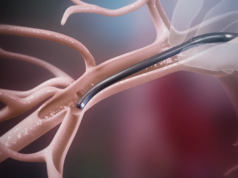
Emboa Medical has announced a novel microstructured catheter which mimics the snake’s evolutionary advantage to improve the retrieval of blood clots that cause stroke.
The company has stated that the catheter has been validated to improve outcomes for stroke patients. Its patent-pending platform, called TRAP, or Thrombus Retrieval Aspiration Platform, emulates a boa constrictor’s teeth arrangement in its biomimetic design to grab onto blood clots without tearing them.
Chief executive officer of Emboa Medical Ángel Enríquez has commented that the TRAP design demonstrated a greater than 200% increase in blockage removal force compared to a traditional catheter.
“Additionally, the TRAP catheter showed significant benefits in removing clots on the first attempt in a worst-case neurovascular model,” he said. “It achieved a 40% success rate compared to 10% for conventional smooth inner diameter catheters.”
Emboa Medical was founded by clinical experts at Goodman Campbell Brain and Spine in Carmel, USA and NYU Langone Health in New York, USA and medical device researchers at Purdue University’s College of Engineering in West Lafayette, USA. TRAP was designed by Enríquez and Hyowon Lee, professor at Purdue’s Weldon School of Biomedical Engineering and director of the Center for Implantable Devices.
Enríquez said Emboa has been diligently working on finalising the design of the microstructures through physiologically relevant models to further establish differentiation among current catheters in the market.
“We have conducted in vitro experiments that quantitatively demonstrate the advantages of TRAP catheters,” he said. “Additionally, we will conduct an in vivo porcine model study and preliminarily validate TRAP’s safety and effectiveness by end of the first quarter of 2025. The successful completion of this animal model study will lead to more functional and robust TRAP devices that can facilitate the transition to larger-scale verification activities toward regulatory approval.”
“The use of traditional stent retrievers results in higher rates of perforation due to the metal struts interacting with the vessel walls. This causes intracranial haemorrhages at a higher rate than aspiration catheters, which apply suction through a tube. This can be asymptomatic or symptomatic, but the truth is no doctor is comfortable causing damage to a patient’s blood vessels,” Enriquez said.
“Thus, aspiration catheters are an attractive tool because they achieve reported faster reperfusion times, lower rates of distal emboli (13.2% versus 3.4%) and vessel injury (9.3% versus 1.8%) at lower costs. Yet the aspiration force is dramatically decreased and limited by the smaller vessel diameter. TRAP was designed to address this obstacle.”










